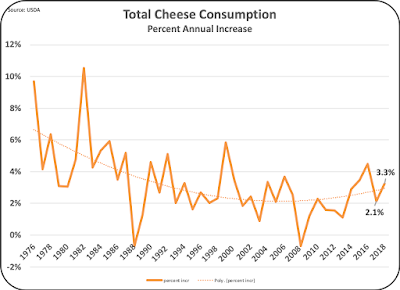Milk protein prices have been low for the last five years. During this time, butterfat prices have been consistently high. Diary producers and their nutritionists have done an exceptional job of increasing butterfat levels in milk to record highs, increasing producer revenue. The market is changing, and it is now time to put a strong emphasis behind increasing milk protein levels in milk. In August, butterfat was worth $2.66/lb. and milk protein was worth $2.45/lb. and was quickly rising.
In the first fifteen years of the current milk pricing formulas, milk protein was consistently worth more than butterfat. For the last five years that pattern reversed, as the butterfat price increased, and the milk protein price decreased. This is changing in 2019 with a surge in milk protein pricing (see the circled area in Chart I).
 |
| Chart I - Milk Protein and Butterfat Prices |
The milk protein price is driven by the 2019 change in cheese pricing - Chart II circled in red. The change in the cheese price is driven primarily by a significant
decline in cheddar cheese production resulting in lower cheddar cheese inventories. Butter prices have remained stable and high, while cheese prices have increased by 36 percent YTD in 2019.
 |
| Chart II - Butter and Cheese NASS Prices |
Table I below shows the butterfat component levels for 2017 and 2018 by Federal Milk Marketing Order (FMMO). Butterfat levels which were once around 3.5 percent of producer milk, are now at 3.9 percent. Increases in the Pacific Northwest have been amazing with a 2018 butterfat average over 4 percent. California became a FMMO in November 2018 and the yearly average is based on two of the most productive months of the year.
 |
| Table I - Butterfat Levels in 2017 and 2018 |
Milk protein levels shown in Table II have increased too, but at a much slower pace. Growth in butterfat increased .06 percent while milk protein increased .01 percent. As will be covered in some of the charts later in the post, protein levels, which have risen slowly in 2018, seem to be rising faster in 2019.
 |
| Table II = Milk Protein Levels in 2017 and 2018 |
FMMO statistics are dominated by the Upper Midwest Order which had 23 percent of the total FMMO milk volume in 2018. Charts III and IV show the butterfat and milk protein levels by year for the Upper Midwest Order. Butterfat levels in 2018 show significant increases from the prior year. For 2018, the average butterfat level was 3.92 percent.
Protein levels shown in Chart IV increased very slightly in 2018. Obviously, the emphasis has been on increasing butterfat levels shown in Chart III. The slow growth of protein levels in producer milk has left an opportunity to increase revenue by increasing protein levels while maintaining or growing butterfat levels. In the Upper Midwest Order, many producers are paid bonuses for higher protein levels. Well over 80% of the milk in the Upper Midwest is used for cheese and higher protein levels are needed to efficiently make cheese. This has created an obvious financial opportunity in the Upper Midwest by increasing producer revenue with higher protein levels. In 2019 YTD it appears that attention is now being focused on improving milk protein levels.
 |
| Chart III - Upper Midwest Order Butterfat Levels |
 |
| Chart IV - Upper Midwest Order Milk Protein Levels |
The second largest FMMO is the Northeast Order with 19 percent of the total FMMO milk volume in 2018. Charts V and VI show the changes in butterfat and milk protein levels in the Northeast Order. The Northeast Order has lagged behind the Upper Midwest in 2018/19 component level growth. Protein levels actually declined from the previous year in the Northeast Order in 2018. Again, there is an opportunity to increase components and revenue with a higher level of both butterfat and milk protein.
 |
| Chart V - Northeast Order Butterfat Levels |
 |
| Chart VI - Northeast Order Milk Protein Levels |
The Pacific Northwest is a much smaller FMMO, with only six percent of the total FMMO milk volume in 2018. The Pacific Northwest is included in this post because they have done an amazing job of increasing component levels.
They have the highest butterfat levels of any FMMO and have continued to increase these levels regularly. The Pacific Northwest also has the highest levels of milk protein of any FMMO and is also continuing to increase those levels significantly.
 |
| Chart VII - Pacific Northwest Order Butterfat Levels |
 |
| Chart VIII - Pacific Northwest Order Protein Levels |
From the data, it appears that the market forces are causing the right things to happen. With higher prices, milk protein is on the increase at a faster rate in 2019 compared to prior years. While there are various factors that can increase component levels, amino acid balancing is one of the proven and most consistent ways to increase butterfat and milk protein levels. There are more and more experts in amino acid technology that can assist producers and their nutritionists in applying amino acid balancing science in nutrition.
In 2018, butterfat percentage increased from 3.82 percent in 2017 to 3.88 percent in 2018. That means that the amount of butterfat in the same amount of milk increased by 1.5 percent. The amount of milk per cow has increased by 1.4 percent per year for the last 20 years. When these increases in components levels and milk per cow increases are compounded, the same number of cows will increase total butterfat volume by nearly three percent every year. This is far above the
needed milk supply. Cow numbers have declined recently, but the decline is not enough.
























